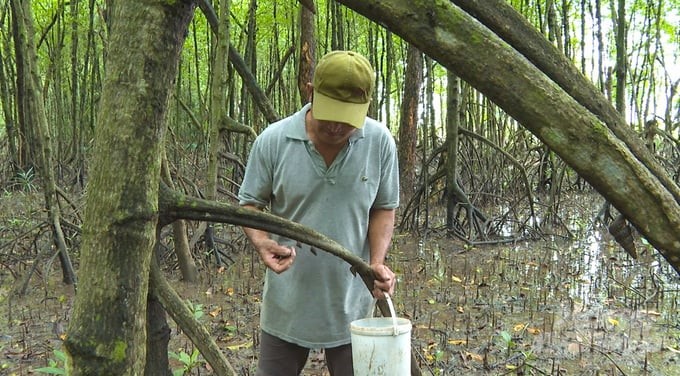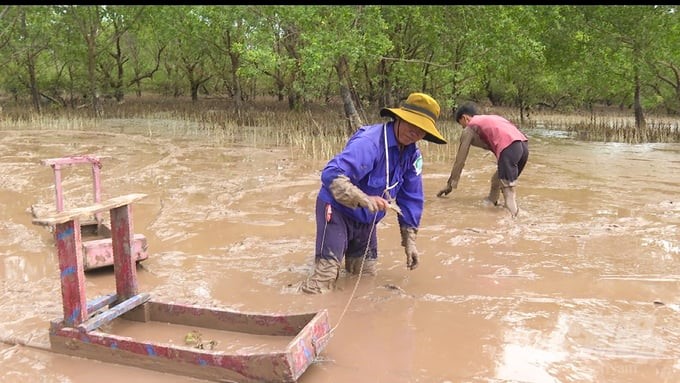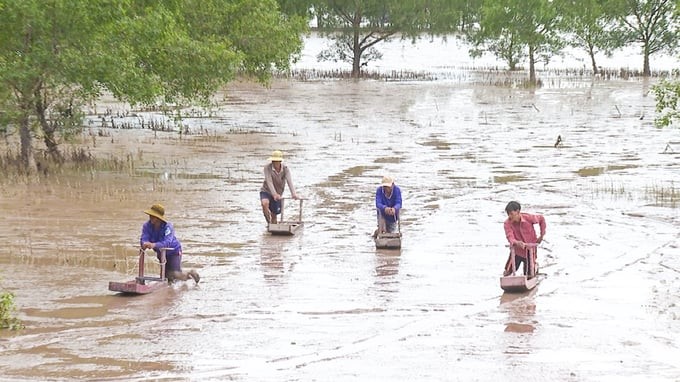November 28, 2025 | 03:36 GMT +7
November 28, 2025 | 03:36 GMT +7
Hotline: 0913.378.918
November 28, 2025 | 03:36 GMT +7
Hotline: 0913.378.918

People harvest wool snails in the protective forest in An Thanh 3 commune, Cu Lao Dung. Photo: Kim Anh.
From the livelihood support model under the project “Mekong Delta Integrated Climate Resilience and Sustainable Livelihoods” (WB9) piloted in An Thanh 3 commune, Cu Lao Dung district, Soc Trang province in 2019, up to now, the locality has formed and replicated more aquaculture areas under the forest canopy.
In particular, co-management groups were established to both protect forests and develop aquaculture. Typically, the model of raising wool snails and sesarmid crabs of the co-management group in Vo Thanh Van hamlet, An Thanh Nam commune, or the model of raising wool snails, sesarmid crabs, and giant mudskippers in the forest management and protection group in An Quoi hamlet, An Thanh 3 commune, etc.
People in these co-management groups are well aware that when forests develop, aquaculture conditions will expand, and income will also increase. Since then, people's awareness and responsibility have changed markedly. People have coordinated with localities to participate in patrolling and protecting farmed aquatic species.
The forest area along the alluvial flat in Mo O hamlet, Trung Binh commune, Tran De district, is home to many aquatic species that appear seasonally, such as blood cockles, gray eel-catfish, giant mudskippers, etc. The majority of people's income sources here are associated with coastal exploitation and fishing. Therefore, developing aquaculture under the forest canopy is essential to reduce the exploitation and catching of natural aquatic resources while still ensuring a stable livelihood and income of several hundred thousand dong per day.

Fishing at the alluvial flat in the Mo O protective forest area, Trung Binh commune, Tran De district. Photo: Kim Anh.
Through the sharing of some households here, the developed forest has created a natural growing space for aquatic species. Everyone agrees and contributes with co-management group members so that the forest trees can grow and develop.
Along the length of the coast of Soc Trang province, as of now, five groups have been formed to co-manage fisheries and protect aquatic resources in association with the protection of protective forests. The groups were established based on the spirit of volunteerism and commitment to implementing seafood exploitation in accordance with regulations. This force becomes the core of helping the agriculture sector disseminate and mobilize fishermen to exploit and catch seafood reasonably on fishing grounds.
Mr. Lu Tan Hoa, Deputy Director of the Soc Trang Provincial Fisheries Sub-Department, acknowledged that in order to exploit and protect aquatic resources more effectively, co-management models must be applied throughout the province’s entire coastal waters. At the same time, it is necessary to have the involvement of relevant agencies to promptly support the group's activities in the process of patrolling, controlling, and handling violations in seafood exploitation activities.
In addition, localities need to continue to develop and support livelihoods for fishermen in coastal areas to reduce economic dependence on exploiting natural aquatic resources. From there, well mobilize the community's strength in the work of protecting coastal aquatic resources in association with protecting the province's coastal protective forests.

Co-management groups actively participate in protecting protective forests in association with protecting aquatic resources under the forest canopy. Photo: Kim Anh.
In recent times, the protection of coastal beneficial resources associated with the protection of protective forests in Soc Trang province has positively contributed to the work of stabilizing livelihoods and preventing natural disasters for the fishing community.
Facing the challenge that coastal aquatic resources are encountering excessive and destructive exploitation and gradually losing the ability to self-regenerate and recover, the establishment of coastal fisheries co-management groups is truly necessary and has become a solution to help protect fishing grounds.
This is also an opportunity to restore order in seafood exploitation in coastal waters, creating good conditions for coastal aquatic resources to be restored and developed.
The project “Mekong Delta Integrated Climate Resilience and Sustainable Livelihoods” (WB9) aims to enhance tools for climate-smart planning and improve climate resilience of land and water management practices in selected Mekong Delta provinces.
The project consists of five components. The first component is enhancing monitoring, analytics, and information systems to undertake ‘smart investments’ and cope with anticipated wide-scale environmental changes. The second component is managing floods in the upper delta to protect the benefits of controlled flooding measures and increase rural incomes in An Giang, Kien Giang, and Dong Thap provinces. The third component is addressing the challenges related to salinity intrusion, coastal erosion, sustainable aquaculture, and improved livelihoods for communities living in the coastal areas of Ben Tre, Tra Vinh, and Soc Trang provinces. The fourth component is addressing the challenges related to coastal erosion, groundwater management, sustainable aquaculture, and improved livelihoods for communities living in the coastal areas of Ca Mau, Bac Lieu, and Kien Giang provinces. The fifth component is supporting project management and capacity building.
Translated by Huyen Vu Thu

(VAN) According to Mr. Vo Minh Thanh, Director of the Tay Ninh Department of Agriculture and Environment, Resolution 57 has created a new development pathway for the locality, shifting from traditional toward modern agriculture.
/2025/11/26/4909-2-154329_878.jpg)
(VAN) Pearl grouper farming in HDPE cages not only delivers economic efficiency but also contributes to protecting the environment, creating jobs, and promoting marine-based experiential tourism.

(VAN) The model of making a living under the forest canopy through the agroforestry system in Van Son commune, Bac Ninh province, is expected to generate an annual income of approximately VND 30 million/ha.

(VAN) Many enterprises in Can Tho are harnessing natural energy and reducing greenhouse gas emissions in their production processes, thereby contributing to the promotion of a sustainable green transition.
/2025/11/24/3536-2-112800_176.jpg)
(VAN) Dong Nai now has tens of thousands of hectares of forests certified for sustainable management, and this area will continue to be expanded in the coming period.

(VAN) Vinh Ha hamlet (Dai Xuyen commune, Hanoi) is shifting away from small-scale farming as households adopt bioscurity into their breeder chicken models.

(VAN) Heavy rains make aquatic species more vulnerable to disease. Proactive water management and high-tech systems help farmers prevent outbreaks and protect yields.